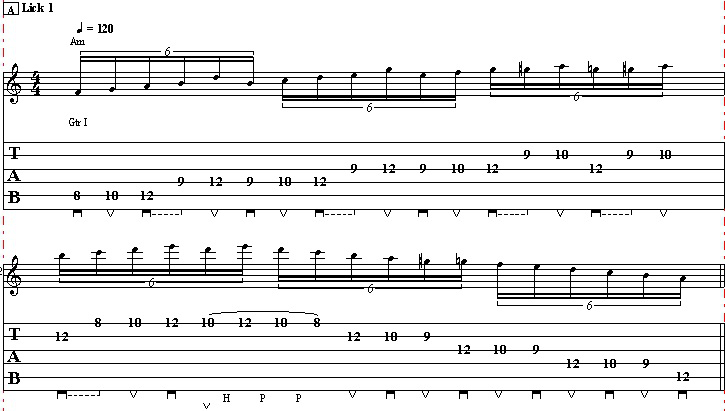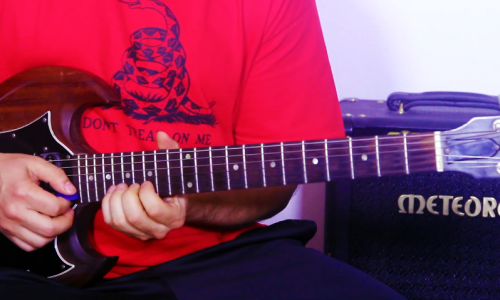How To Play Rock Lobster On Guitar
In this Guitar Control video tutorial instructor Robert Baker, breaks down the techniques and main riffs in this Classic new wave B52’s song called “Rock Lobster”. Robert describes this riff as awesome and one of those riffs that makes you laugh. It’s very fun to play and uses a clean style guitar tone with a little grit, but not too much. You may even heard it on Family Guy when Peter Griffin does a spoof on it!
Robert is going to show us a bunch of main riffs, he isn’t going to cover every single detail of the song, but he will cover all of the main riffs used. The actual song is tuned to Drop C, but Robert is going to demonstrate it in this video in Drop D. To tune to Drop D the only thing is to drop the low e, 6th string, down one whole step to a D note. To tune to Drop C it would be the same idea, except your entire guitar would be dropped down a whole step and tuned to D and then you would also drop the 6th string an additional step, making it a C. So every string would be dropped down one step, and the 6th string would be dropped down two.

Check the image above to follow the chords and tabs.
Step 1: The Intro Riff
The first riff, Robert is going to go over in this “Rock Lobster” guitar tutorial is the iconic main riff, you most likely identify this song with, and the first riff that starts the song off. Start by picking the open 6th string twice, one down, and one up stroke. Then pick the 6th string 2nd fret and then the 6th string 3rd fret, back to the 6th string 2nd fret, back to the open 6th string. Then go up to the 8th fret on the 6th string and pick it once, and then pick the 5th fret 6th string once, then pick the 8th fret on the 6th string again but now go to the 7th fret 6th string and pick it twice. There is a flight delay in when you pick it twice though, using the second time as almost a lead in back to repeating everything we just did and go back to the open 6th string, then repeat all. Have a lot of fun playing this riff and make sure to put a lot of feelings and attitude into it, because that what makes this riff stand out.
Step 2: The Chorus and Bridge
The next riff is super simple. You are going to pick the open 6th string for one measure full of eighth notes. So picking down and up a total of 8 times. Down, up, down, up, down, up, down, up, counting one, and two, and three, and four. Then go to the 6th string 3rd fret and do the same thing, alternating between down and up picks all eighth notes for one measure.
Then same thing on the 5th string 1st fret, and then same thing on the open A, the 5th string. This part serves like a chorus, then repeat it all again. Then you’re going to do the same movements but the rhythm changes slightly. It goes from 8 picks, which is 4 full beats, to 4 picks, which is 2 full beats. So down, up, down, up, change. Then it changes even faster to only 2 picks on each note, still the same movement and order of notes, but now just down up change, so one full beat on each note. This takes us back to the intro/main riff! If you are enjoying learning this catchy riff make sure to check out our video how to play No Quarter on guitar, for another!
Now, the bridge starts chromatically playing the 3rd, to 4th, to 5th frets all on the 5th string, but when he gets to the 5th fret he plays it 8 times in the eighth note rhythm, one, and two, and three, and four. Then he does that same rhythm picking the open 6th string 8 times and then back to the 5th fret 5th string. Back to the low e, the open 6th string and does that a total of four times. Then he just picks each note once bouncing back and forth, so 5th fret 5th string to the open 6th string three times and ends by plucking the 5th fret 5th string once and right back into the main riff!
Step 3: Descending Chromatic Line
For this whole section we just alternate picking, which means we alternate back and forth between down and up strokes with our pick on the strings. The line starts on the 1st string 9th fret, picked 8 times, so one, and two, and three, and four. All eighth notes the same thing chromatically all the way down to the 1st fret on the 1st string. So all on the 1st string going from the 9th fret, to the 8th, to the 7th, to the 6th, to the 5th , to the 4th, to the 3rd, to the 2nd, to the 1st. The 2nd string continuing with the same eighth note rhythm and alternate picking, now picking the 2nd fret 2nd string to the 1st fret 2nd string. Then you alternate between the open 2nd string and the 1st fret 2nd string but picking down up only and changing, so just one beat for each note, two eighth notes and of course alternate picking all of it still. Repeat 4 times and then back to the main riff.
Step 4: The Final Two Riffs For This Lesson
Start with a drop d power chord, which means we just bar the 6th and 5th strings with one finger to play a power chord. This is a result of the tuning. It’s the same interval as a power chord in standard tuning but in standard tuning you would have one finger on the 6th string and then your ring or pinky finger string down and a fret two frets down.
Starting with a drop d power chord on the 5th string, barring both the 6th and 5th strings on the 5th fret with your pointer. Then go to the 6th string 8th fret barring the 6th and 5th strings and play that drop d power chord. Then a drop d power chord on the 10th fret 6th string baring both the 6th and 5th strings, play this chord twice with a little rhythmic break in between where it almost sounds like you’d scratch or mute for a second to give this riff a jumpy, upbeat feel.
Then straight back barring the 8th fret, 6th, and 5th strings, and strum it once. Then you’re going to play the exact same thing, but when you get the 10th fret this time, the second time, through, just pick it once and go straight back to the 8th fret instead of picking it twice like you did the first time through. And of course, these are all drop d bar chords the 6th string and 5th strings barred with your pointer finger. Before Robert repeats the riff the second time, so in between the very first time and the variation he scratches the guitar while muting it with an up and a down strum.
The final riff, this song gets a little repetitive so this is going to be the last riff Robert covers for “Rock Lobster”. So we’re using the same drop d power chords, barring the 6th and 5th strings starting on the 5th fret strumming down, down, down, down, up, then going to the 3rd fret on the 6th string barring both the 6th, and 5th strings, and strumming up, down, up, down, up, down, up. Then strum on the 3rd fret, its pretty much a straight eighth note strum, but they left out the very first down on beat one, starting with straight eighth notes coming in on the and of beat two.
Recap: How To Play Rock Lobster On Guitar
I hope you enjoyed Roberts lesson on how to play “Rock Lobster on Guitar”. This song is great for beginners because it isn’t too difficult and they use a lot of the same notes with slight variations throughout the different riffs. Be sure to pay attention when Robert explains the slight variations since most of the parts will sound fairly similar.



